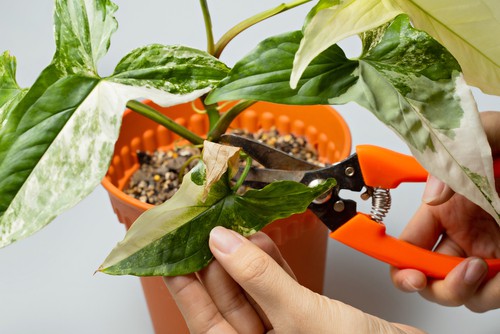Arrowhead plants are a popular houseplant that is known for its beautiful foliage and easy care. However, if you notice that the leaves of your arrowhead plant turning yellow, it could be a sign that something is wrong. Understanding the causes of yellowing in arrowhead plants is essential to diagnose and treat the problem effectively.
There can be several reasons why arrowhead plant leaves turn yellow, including overwatering, underwatering, wrong lighting, temperature fluctuations, low humidity, insufficient nutrition, pest and diseases, and natural aging. To determine the cause of yellowing,
it is essential to look for other symptoms such as wilting, leaf drop, or discoloration. Once you diagnose the problem, you can take steps to care for your arrowhead plant and prevent yellowing in the future.
Key Takeaways
- Arrowhead plants are prone to yellowing, which can be caused by several factors such as overwatering, underwatering, wrong lighting, temperature fluctuations, low humidity, insufficient nutrition, pest and diseases, and natural aging.
- To diagnose the cause of yellowing, look for other symptoms such as wilting, leaf drop, or discoloration.
- Once you identify the problem, take steps to care for your arrowhead plant and prevent yellowing in the future.
You might also like these other top posts:
- Blueberry Leaves Turning Yellow with Brown Spots:
- Bleeding Heart Plant Turning Yellow:
- Blackberry Leaves Turning Yellow:
Understanding Arrowhead Plant Yellowing
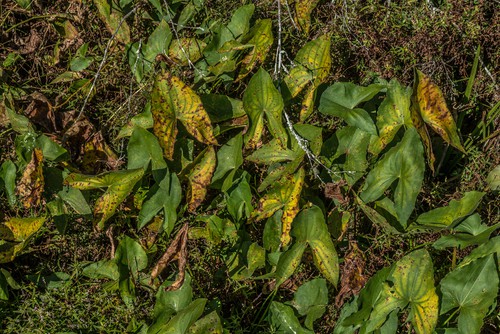
Arrowhead plants are popular indoor plants that are known for their attractive foliage. However, yellowing leaves can be a common issue that many Arrowhead plant owners face. Understanding the causes of yellowing leaves can help you prevent and treat this problem effectively.
One of the most common causes of yellowing leaves in Arrowhead plants is improper soil moisture. Overwatering can lead to yellowing leaves, while underwatering can cause leaves to dry out and turn yellow.
It is important to water your Arrowhead plant when 50% of the soil volume is dry. This will prevent overwatering and ensure that your plant gets the moisture it needs to thrive.
Another cause of yellowing leaves in Arrowhead plants is natural aging. Mature leaves will naturally turn yellow and fall off, which is a normal part of the plant’s growth cycle. However, if you notice yellowing leaves on new growth, this could be a sign of a problem.
In addition to these causes, there are other factors that can contribute to yellowing leaves in Arrowhead plants. These include:
- Lack of sunlight: Arrowhead plants require bright, indirect light to thrive. If your plant is not getting enough light, it may start to develop yellow leaves.
- Nutrient deficiencies: Arrowhead plants require certain nutrients to grow and thrive. If your plant is not getting the right nutrients, it may develop yellow leaves.
- Pests: Pests such as spider mites and mealybugs can damage Arrowhead plants and cause yellowing leaves.
If you notice yellowing leaves on your Arrowhead plant, it is important to take action to address the underlying problem. This may involve adjusting your watering schedule, providing more sunlight, or treating your plant for pests. With the right care, your Arrowhead plant can thrive and continue to provide you with beautiful foliage for years to come.
Arrowhead Plant Turning Yellow – Common Problems
Arrowhead plants are popular indoor plants that are easy to care for and can add a touch of greenery to any room. However, one common problem that many people face with their arrowhead plants is yellowing leaves. There are several potential causes for this issue, and it is important to identify the root cause in order to take appropriate action.
One of the most common causes of yellowing leaves in arrowhead plants is improper soil moisture. Overwatering can lead to an excess of moisture in the soil, causing the leaves to become yellow and wilted.
On the other hand, underwatering can also cause yellowing leaves, as the plant is not receiving enough water to support healthy growth. It is important to ensure consistent soil moisture by watering the plant when the topsoil in the pot is dry to the touch.
Lighting needs can also play a role in yellowing leaves. Arrowhead plants prefer bright, indirect light, and may struggle in low light conditions. If the plant is not receiving enough light, the leaves may turn yellow and drop off. Conversely, if the plant is exposed to too much direct sunlight, the leaves may become scorched and turn yellow or brown.
Humidity levels can also impact the health of arrowhead plants. These plants prefer a relatively high humidity environment, and may struggle in dry air. Low humidity levels can cause the leaves to become dry and brittle, and may result in yellowing or browning of the leaves.
To increase humidity levels, consider using a humidifier or placing a tray of water near the plant.
Finally, nutrient deficiencies can also cause yellowing leaves in arrowhead plants. If the plant is not receiving enough nitrogen, magnesium, or other essential nutrients, the leaves may turn yellow or brown. It is important to fertilize the plant regularly with a balanced fertilizer to ensure that it is receiving all of the necessary nutrients for healthy growth.
By identifying and addressing the underlying cause of yellowing leaves in arrowhead plants, it is possible to restore the plant to its full health and beauty.
Symptoms and Diagnosis
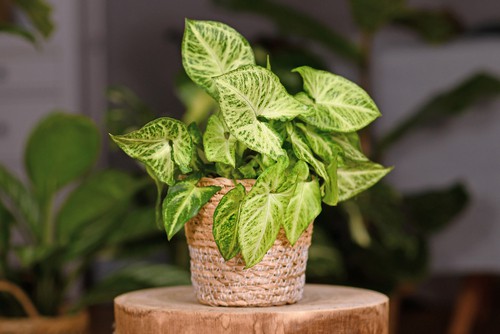
Arrowhead plants are known for their attractive foliage and ease of care. However, yellowing leaves can be a sign of a problem. It is important to diagnose the issue promptly to prevent further damage to the plant.
1. Yellowing Leaves
Yellowing leaves are a common symptom of arrowhead plants. This can be caused by a variety of factors, including overwatering, underwatering, low humidity, and nutrient deficiencies. If the leaves are yellow and falling off, it means the plant is being overwatered. On the other hand, if the leaves are dry and crispy, it may be a sign of underwatering.
2. New Growth
New growth is a good indicator of the overall health of the plant. If the new growth is yellow or stunted, it may be a sign of a nutrient deficiency. However, if the new growth is healthy and green, it is a good sign that the plant is recovering.
3. Old Leaves
Old leaves naturally turn yellow and fall off. If only the old leaves are turning yellow, it may be a sign of normal aging. However, if the yellowing is widespread and affecting new growth, it may be a sign of a problem.
4. Leaf Shape
Arrowhead plants have distinctive arrow-shaped leaves. If the leaves are becoming misshapen or distorted, it may be a sign of an insect infestation or disease.
5. Brown Spots
Brown spots on the leaves can be caused by a variety of factors, including fungal infections, bacterial infections, and insect infestations. It is important to diagnose the cause of the brown spots promptly to prevent further damage to the plant.
6. Shriveling
Shriveling leaves can be a sign of underwatering or low humidity. It is important to water the plant properly and provide adequate humidity to prevent further damage.
7. Variegation
Variegation is a desirable trait in arrowhead plants. If the variegation is fading or disappearing, it may be a sign of a nutrient deficiency or other problem.
Care and Treatment for Yellowing Arrowhead Plant
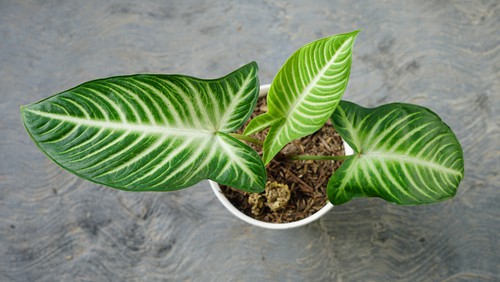
When an arrowhead plant starts turning yellow, it is a sign that something is wrong with its care. The first step in treating a yellowing arrowhead plant is to identify the cause of the problem.
One common cause of yellowing leaves in arrowhead plants is low humidity levels. Arrowhead plants require a high level of humidity to thrive. If the humidity level is too low, the leaves will start to turn yellow and brown. To increase the humidity level, mist the leaves regularly or place the plant on a pebble tray. Another option is to use a humidifier in the room where the plant is located.
Overwatering is another common cause of yellowing leaves in arrowhead plants. Overwatering can lead to root rot, which can cause the leaves to turn yellow and wilt. To prevent overwatering, only water the plant when the top inch of soil is dry. Use a moisture meter to determine when the plant needs water.
Repotting the arrowhead plant in fresh, well-draining soil can also help to reverse yellowing leaves. When repotting, make sure to remove any dead or damaged roots.
During the dormant season, arrowhead plants require less water and fertilizer. Reduce the watering schedule and stop fertilizing during this time.
Pruning the arrowhead plant can also help to promote healthy growth and prevent yellowing leaves. Remove any yellow or dead leaves, as well as any stems that are growing in the wrong direction.
If the yellowing leaves are caused by pests, such as spider mites or mealybugs, use insecticidal soap to treat the plant. Follow the instructions on the label carefully to avoid damaging the plant.
By adjusting watering, increasing humidity, repotting, pruning, and treating pests, it is possible to care for and treat a yellowing arrowhead plant.
Prevention of Yellowing in Arrowhead Plants
Arrowhead plants are generally easy to care for, but they can be prone to yellowing, which can be caused by a variety of factors such as overwatering, underwatering, low humidity, and insufficient nutrition.
To prevent yellowing in arrowhead plants, it is important to provide them with the right conditions. Arrowhead plants, also known as Syngonium or Syngonium podophyllum, are native to South America and thrive in subtropical and tropical environments. They can grow outdoors in Florida, but they are commonly grown as houseplants.
One of the most important factors in preventing yellowing is providing the right amount of light. Arrowhead plants prefer bright indirect sunlight, but they can also tolerate low light conditions. Direct sun can burn the leaves, so it is important to avoid placing them in direct sunlight.
Another key factor is proper watering. Overwatering is a common cause of yellowing in arrowhead plants, so it is important to allow the soil to dry out between waterings. Only water the plant when the top inch of soil is dry. It is also important to ensure that the plant is not sitting in standing water, as this can lead to root rot.
Humidity is also important for arrowhead plants, as they prefer a humid environment. To increase humidity, the plant can be misted regularly or placed on a tray of pebbles filled with water.
Finally, it is important to provide the plant with proper nutrition. Arrowhead plants should be fertilized every two to four weeks during the growing season with a balanced fertilizer.
By providing the right amount of light, water, humidity, and nutrition, arrowhead plants can thrive and avoid yellowing.
Frequently Asked Questions
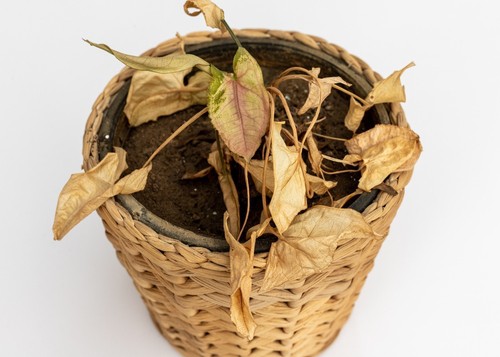
Why is my Arrowhead Plant drooping and turning yellow?
Arrowhead Plants can droop and turn yellow due to overwatering, underwatering, insufficient light, or pests. The most common cause is overwatering, which can lead to root rot and yellowing leaves. It is important to water the plant only when the top inch of soil is dry and to ensure proper drainage.
Can yellow leaves turn green again?
Yellow leaves cannot turn green again, but healthy new growth can replace them. It is important to identify and address the underlying cause of yellowing leaves to prevent further damage.
How do you save a dying Arrowhead Plant?
To save a dying Arrowhead Plant, first identify and address the underlying cause of the problem. This could be overwatering, underwatering, pests, or insufficient light. If the plant is severely damaged, consider pruning it back and repotting it in fresh soil.
How often should I water Arrowhead?
Arrowhead Plants prefer consistently moist soil but do not like to be overwatered. Water the plant when the top inch of soil is dry, and ensure proper drainage to prevent root rot.
What causes brown spots on Arrowhead Plant leaves?
Brown spots on Arrowhead Plant leaves can be caused by overwatering, underwatering, pests, or fungal infections. It is important to identify the underlying cause and address it promptly to prevent further damage.
Why is my Arrowhead Plant crispy and brown?
An Arrowhead Plant can become crispy and brown due to underwatering, low humidity, or exposure to direct sunlight. Ensure that the plant is watered regularly and placed in a location with bright, indirect light. Consider using a humidifier or placing a tray of water near the plant to increase humidity levels.

Hey, I’m Lisa and I’ve been an avid gardener for over 30 years. I love writing, talking and living in the garden! Feel free to connect with me on my socials below

